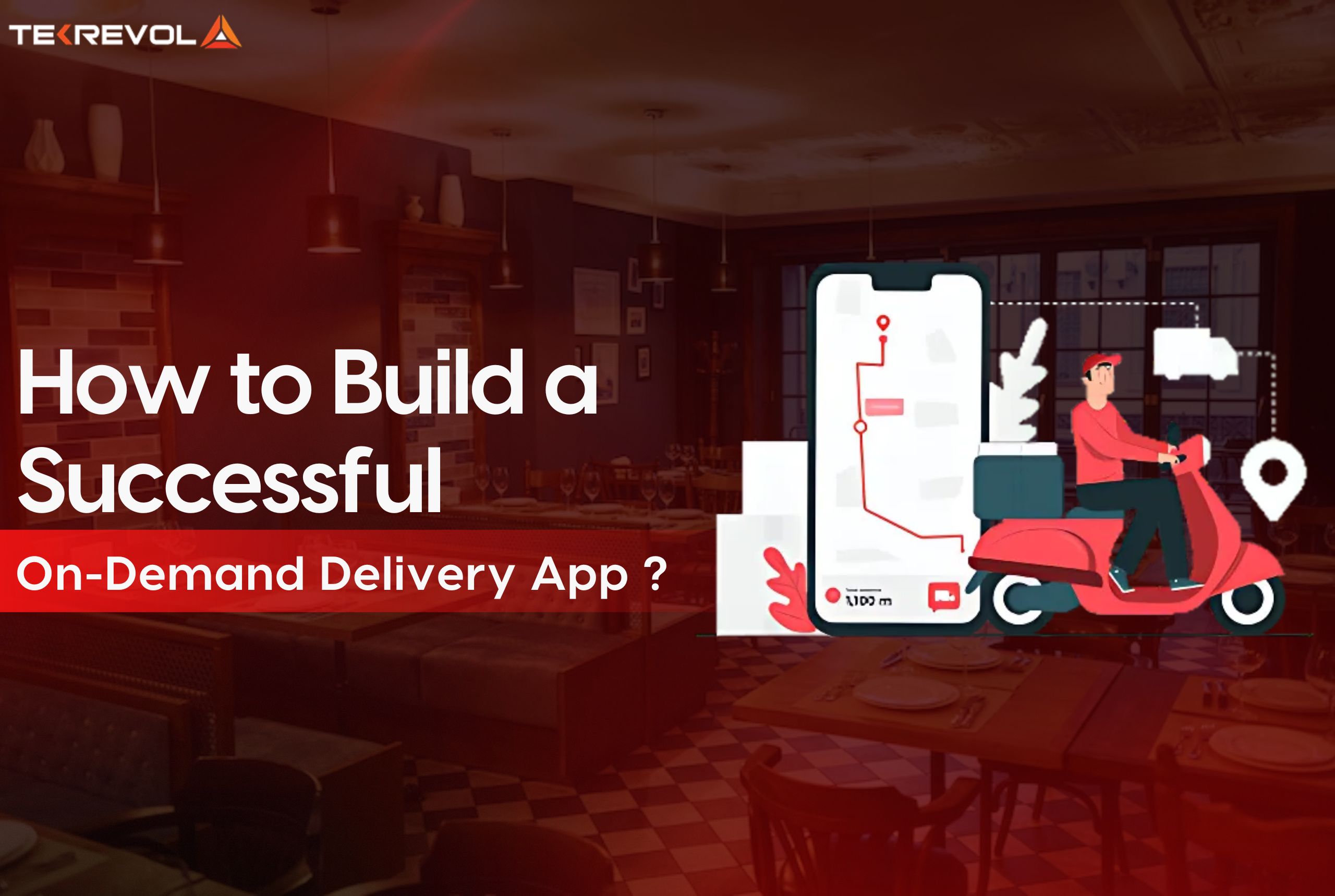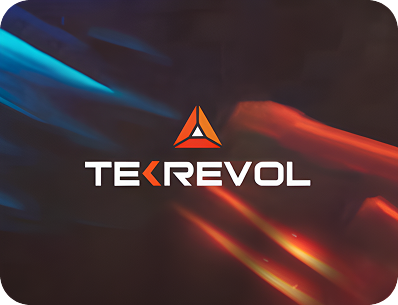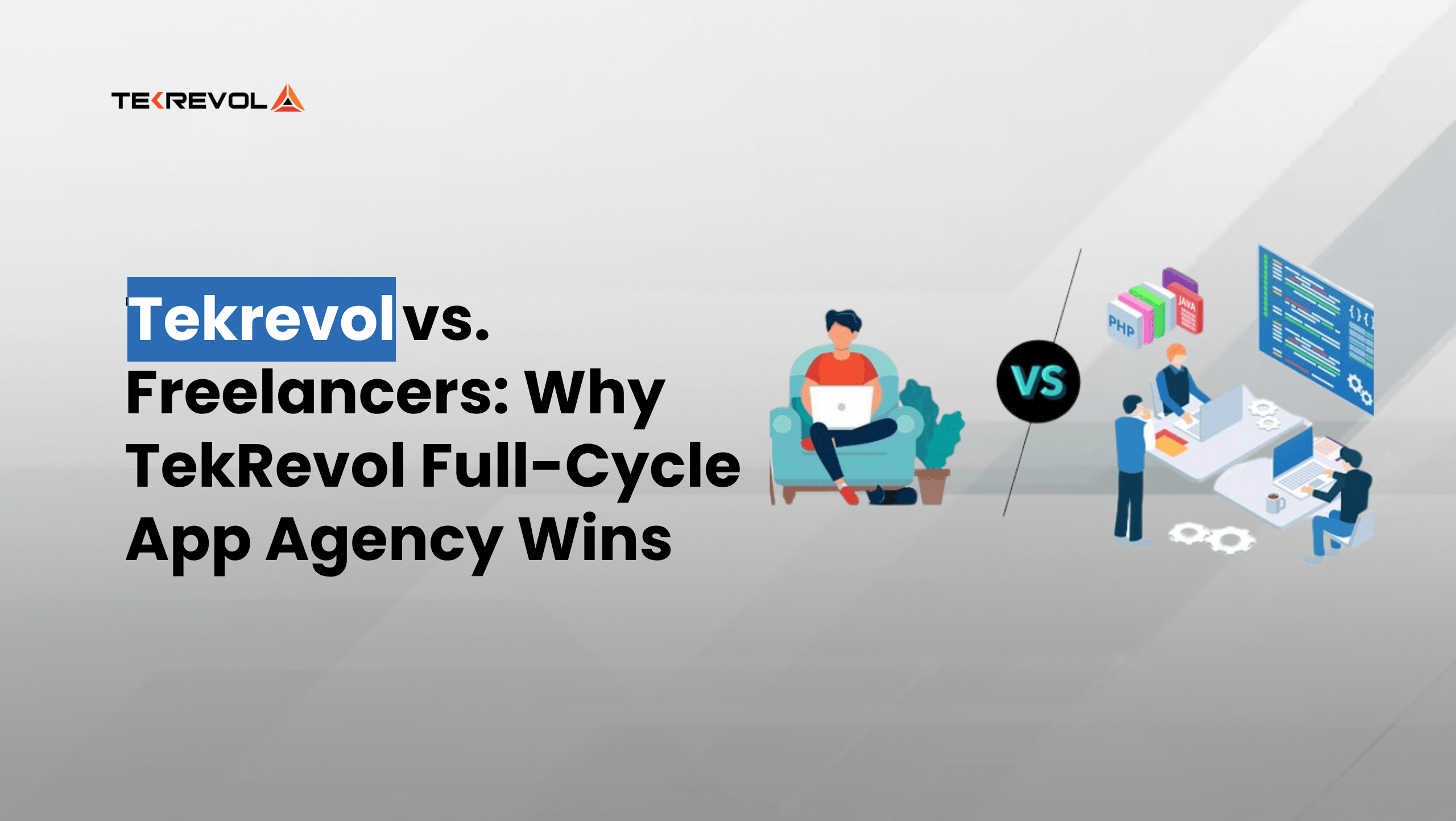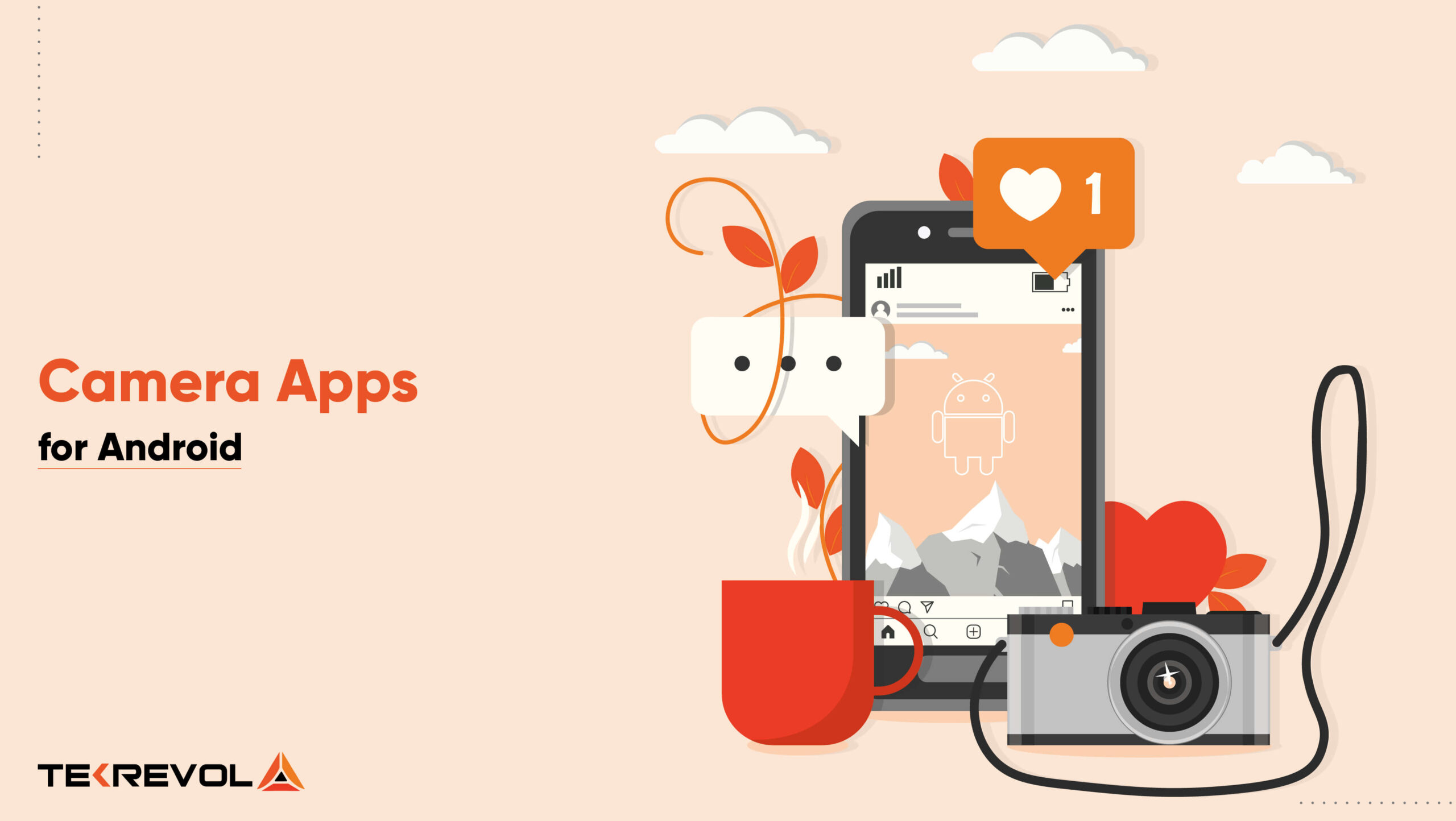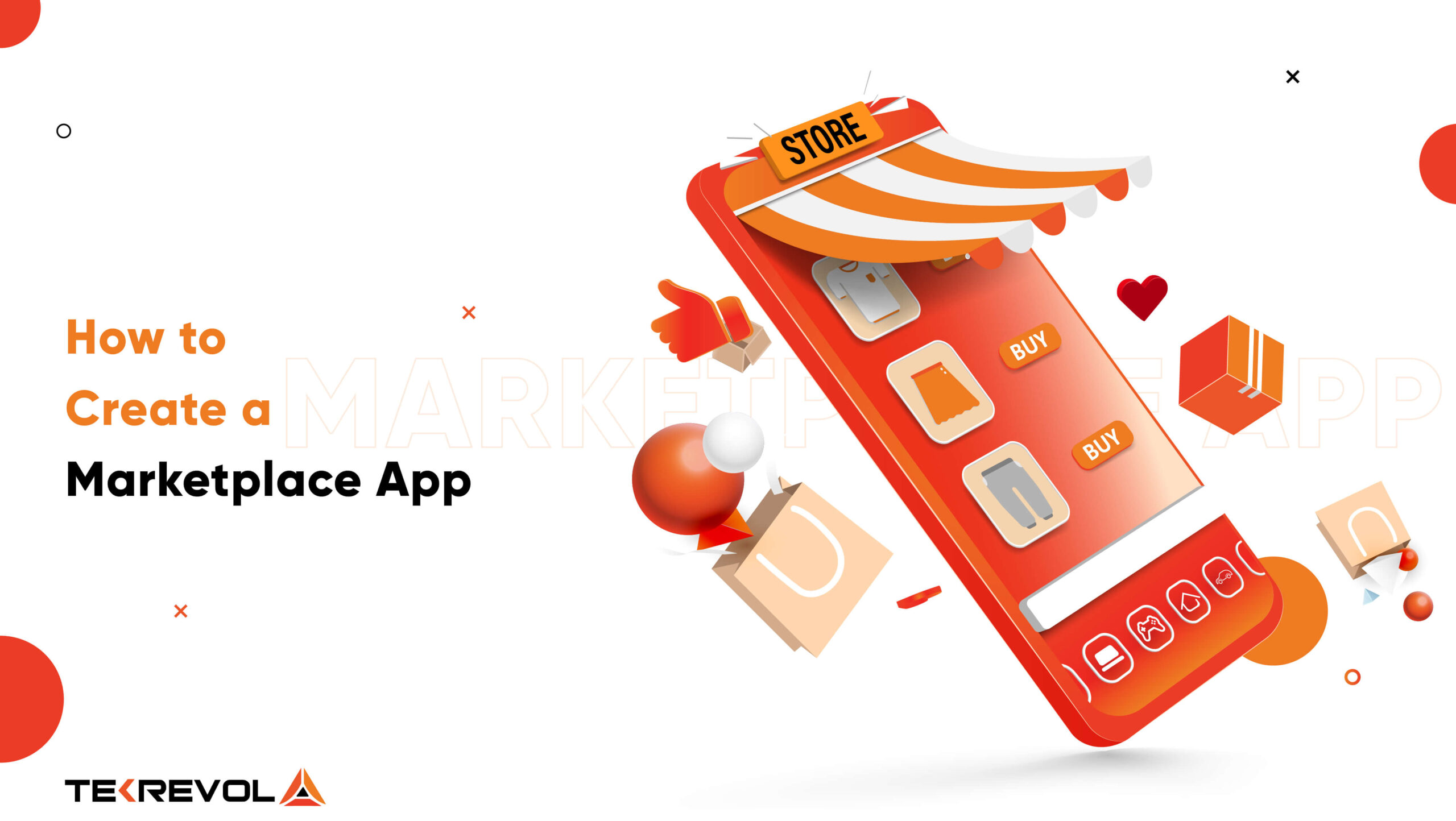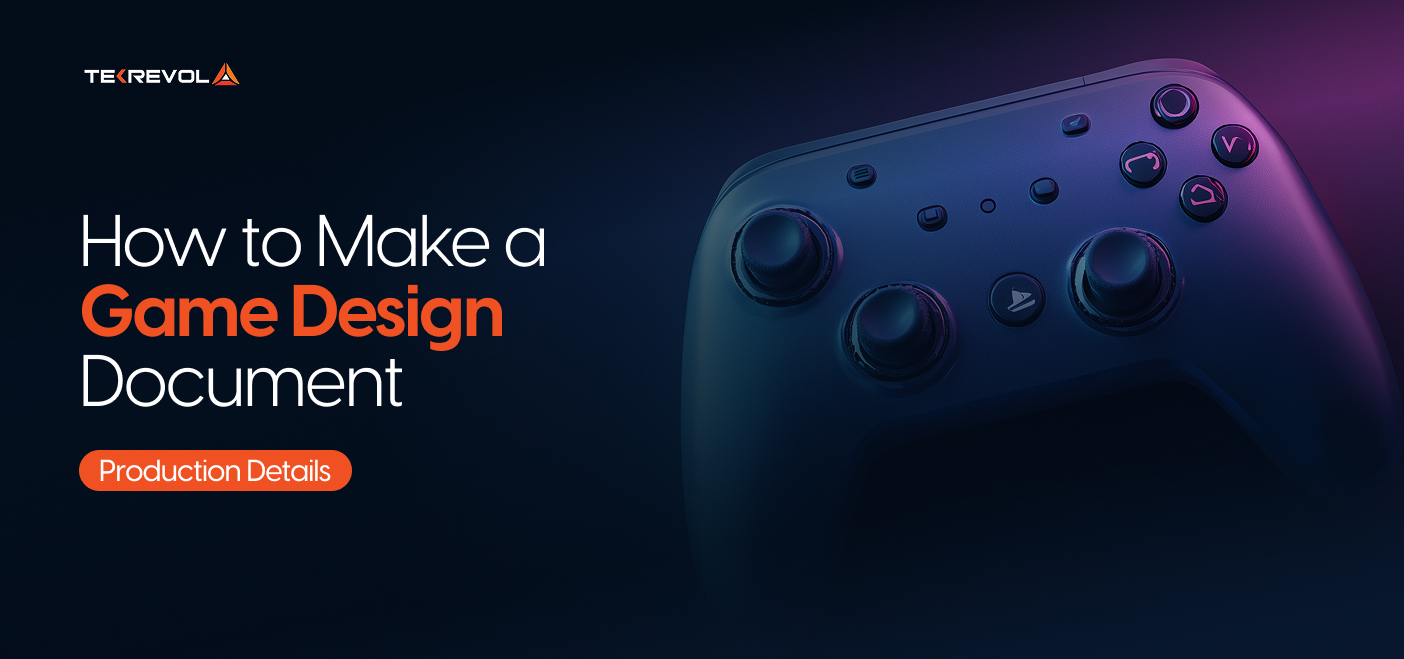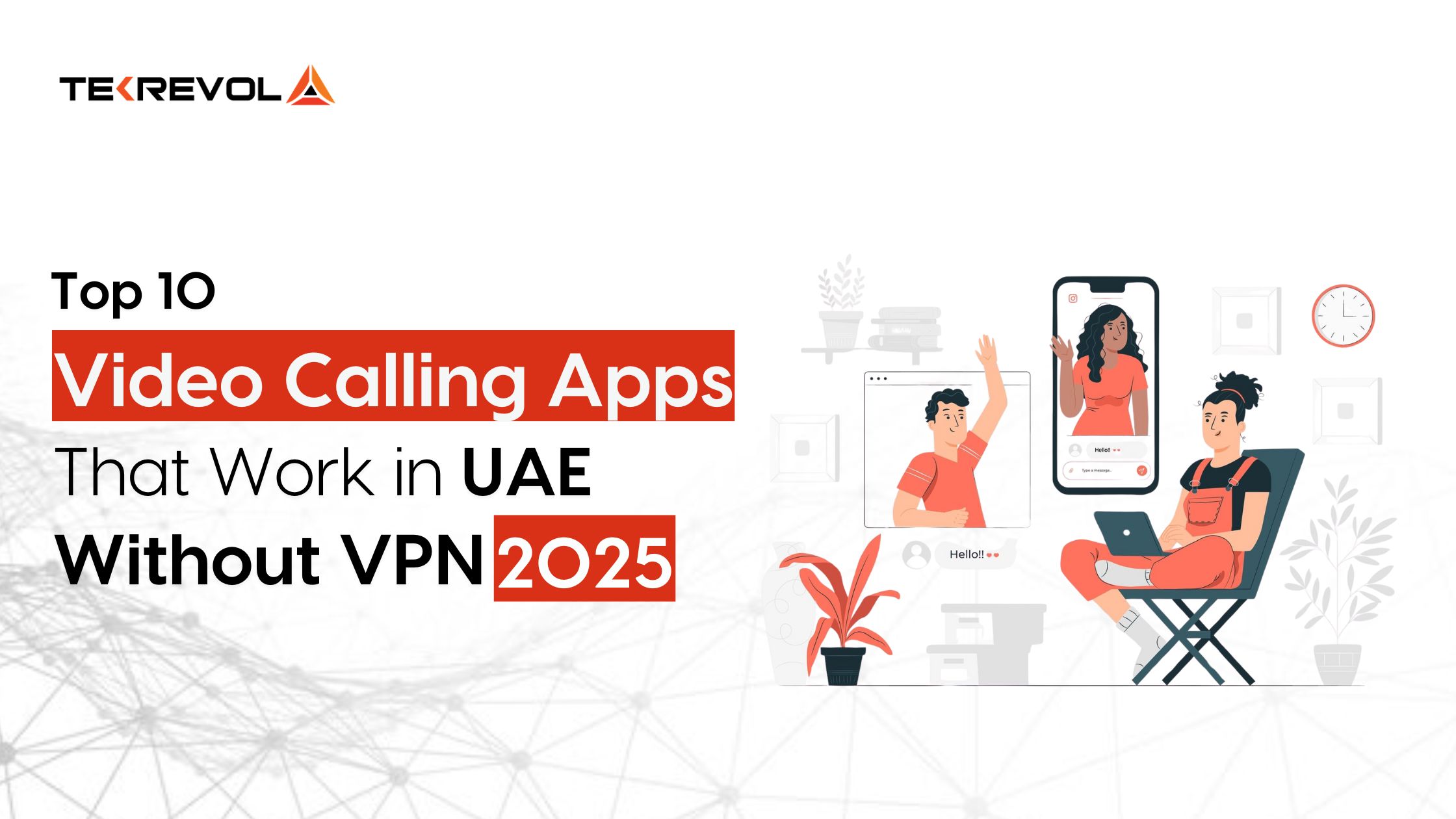Remember when getting groceries meant an actual trip to the store? Or when waiting three days for a delivery felt normal? Those days are long gone. From your morning coffee to those late-night cravings, on-demand delivery has completely changed how we live.
Ready to jump into this massive trend? On-demand delivery isn’t slowing down either. It was already a $143.8 billion industry in 2021 and is heading toward $428.9 billion by 2031.
So, if you’ve been thinking about launching your own on-demand delivery app, one that truly gets what users need and delivers it fast, you’re in the right place.
This guide walks you through each stage of building your on-demand delivery app development, from researching your market and defining key features to selecting the right tech stack and choosing smart monetization strategies.
So, let’s get started!
What Is an On-Demand Delivery App?
An on-demand delivery application is a web-based platform where users are brought together with service providers or delivery personnel to meet a specific requirement, speedily and effectively. Be it food, groceries, medicine, parcels, or laundry, these applications enable users to order and have it delivered to their doorsteps, sometimes in minutes or hours.
The app is a real-time connector of consumers, businesses, and delivery professionals, simplifying the process from product choice to payment to final-mile delivery.
If you’re looking to build your next on-demand app but are confused about where to start and what ideas to explore, check out our guide: Best On-Demand App Ideas to Launch Your Profitable Startup in 2025.
How to Build an On-Demand Delivery App: Step-by-Step Process
On-demand delivery apps have changed the game, from ordering dinner to getting daily essentials at your doorstep in minutes. Thinking of building one? Here’s your go-to guide to create an on-demand app that actually delivers results.
Step 1: Validate the Market
Before we get into how to create a delivery app, step back. The actual question is “Does the market even need your app?”
What to Do Instead:
- Learn from the Competition: Observe major players such as DoorDash or Zepto. Don’t copy them; find out what they’re getting right and where users feel disappointed.
- Identify the Holes: Is there a gap in delivery services? Local stores might be without tech support, and late-night deliveries could be insufficient in some regions.
- Define Your UVP: Your Unique Value Proposition must be able to answer the following question: Why will users select your app over all the others? Identify a niche or service quality gap and claim it.
Step 2: Know Exactly Who You’re Building For
Your app won’t be successful if you don’t know the people who are going to use it. Learning about your target audience is as important as the technology that goes into your app.
Actionable Ways to Learn About Your Users
- Surveys & Interviews: Speak with actual users. What annoys them about existing apps? What’s lacking? What would make them change to a new app?
- Behavioral Insights: Employ analytics software and reports to chart how your prospective users live, shop, and think. Check out age, place, device usage, and daily activities.
- Competitor User Feedback: Check out reviews on the App Store and Google Play. Listen in on what people love and dislike about comparable apps.
Step 3: Pinpoint Market Gaps and Seize the Opportunity
Now that you know your target, it’s time to find gaps your competitors overlooked. Those blind spots may be your greatest strength.
Techniques to Find Market Gaps:
- SWOT Analysis: Assess the landscape of delivery apps. What are others excelling at (Strengths)? Where are they shortchanging themselves (Weaknesses)? What upcoming trends can you get in on (Opportunities)? What threats might impact your success?
- Trend Scanning: Keep an eye out for a change in user behavior or technology, such as people wanting eco-friendly deliveries, same-minute grocery purchases, or hyperlocal convenience.
- Localized Needs: Not all cities or regions are the same. Be on the lookout for underserved markets or delivery niches that don’t have user needs fulfilled.
Step 4: Decide How to Build Your On-Demand Delivery App
When you’ve finalized your unique value proposition, the next big question is: how do you create your app? This choice determines your budget, timeline, scalability, and ultimate success.
You have three main choices:
Option 1: Hire an In-House Team
This strategy offers you complete control and a team that’s highly committed to your product vision. It’s perfect for long-term projects with changing roadmaps.
| Pros | Cons |
| Direct control over development | High fixed costs (salaries, benefits, infrastructure) |
| Faster in-team communication | Time-consuming recruitment process |
| Better for continuous feature updates | May lack niche technical expertise |
Best for: Startups with long-term goals and resources to invest in ongoing development.
Option 2: Outsource to an Agency
Outsourcing provides access to skilled developers, eliminates recruitment time, and reduces upfront expenses. It’s ideal if you need to launch quickly or create a logistics-dense app with outside expertise.
| Pros | Cons |
| Quicker time to market | Less control of day-to-day operations |
| Economical and scalable | Risk of variable quality without proper due diligence |
| Access to expert talent and technologies | Possible reliance on one vendor |
What to Look for in an Outsourcing Partner
- Proven track record with on-demand apps
- Good client testimonials (refer to Clutch or GoodFirms)
- Working knowledge of specified tech stacks (iOS, Android, Flutter, etc.)
- Transparent scope, pricing, and post-launch maintenance
Note: TekRevol is a leading on-demand app development company. If you’re looking to outsource your on-demand app project, we offer expert teams and end-to-end development solutions tailored to your goals.
Option 3: Hybrid Solution (In-House + Outsourced)
Go lean with an in-house team for essential activities, and hire outside experts for specialty requirements such as UI/UX, backend, or scaling.
Best for: Businesses that want flexibility and balance between control and velocity.
Pro Tip: If you’re going in-house, assemble a lean core team and fill in with contractors or agency assistance as necessary. Allows you to adapt quickly without overcommitting resources.
Step 5: Define the Right Business Model for Your Delivery App
Lock in your business model before diving into development. Why? How your app operates, generates revenue, and scales has a direct effect on its long-term success.
Let’s look at your top choices:
1. Single-Store Model
This model is great if you’re a restaurant or retail company running everything in-house, from inventory to delivery.
| Pros | Cons |
| Complete control over pricing, branding, and customer experience | You have to maintain your own delivery fleet |
| No third-party commission fees | Increased cost of operations |
| Direct customer interaction and access to customer data | Smaller customer base without the exposure of aggregators |
Best For: Local businesses or established brands that seek full control and brand loyalty.
2. Aggregator Model
This model connects multiple vendors and allows users to browse, order, and pay via the app. Uber Eats or Glovo is what comes to mind.
| Pros | Cons |
| Rapid scaling via onboarding partners | High commission fees |
| No need to handle deliveries | Less control over branding and customer data |
| Larger audience reach | Your business faces intense competition. |
Best For: Startups prioritizing scale and partnerships over brand ownership.
3. Hybrid Model
Some of them handle some deliveries themselves and partner with third-party companies for others.
| Pros | Cons |
| Flexible delivery options | Complex operations and logistics |
| Wider market reach | Requires syncing in-house and external delivery teams |
| More control over cost and logistics | Can drive up costs if not well managed |
Best For: Companies seeking scalability without losing control.
Tip for Selecting the Right Model: Ask Yourself
- Do you have in-house logistics capability? If not, use an aggregator or hybrid model.
- Do you desire control over your customer and brand experience? Use a single-store or hybrid model.
- Are you marketing to a mass or local market? Aggregators work better for larger markets.
- How rapidly do you wish to expand? Aggregators take you there quickly, whereas single-store models necessitate slow growth.
- Can you operate a delivery fleet? If not, use third-party logistics.
Step 6: Choose the Right On-Demand Delivery App Type
The market for delivery apps has grown well beyond restaurant takeout alone. Various business models have provided the impetus for specialized delivery apps that cater to specific customer needs. Knowing these kinds will assist you in selecting the ideal solution for your business.
| Delivery App Type | Description | App Revenue Model | Key Considerations | Examples |
| Restaurant Aggregator Apps | Lists multiple restaurants in one app, and connects users for orders. | Commission per order | Needs a large partner network and strong marketing | Grubhub, Uber Eats |
| Dark Kitchen | Delivery-only kitchens with no dine-in space. | Direct orders, digital marketing | Lower costs, but requires a kitchen setup investment | CloudKitchens, Reef |
| Full-Service Delivery | Handles orders, delivery, and logistics in-house. | Delivery fees, service charges | High setup cost, but complete business control | Local food chains |
| B2B Food Delivery | Supplies bulk ingredients to restaurants and food businesses. | Transaction fees, recurring revenue | Needs supply chain and logistics management | Restaurant Depot, Choco |
| Grocery Delivery | Let’s users order groceries from nearby stores or supermarkets. | Service fees, markups, subscriptions | Partner with retailers and optimize delivery routes | Instacart, Amazon Fresh |
Step 7: Choose the Right Features for Your On-Demand Delivery App
After establishing your app type and business strategy, the next critical step is selecting features that align with your goals. These choices influence user experience, retention, and operational performance.
| Basic Features | Advanced Features | Nice-to-Have Add-ons |
| User registration/login | AI-based search & recommendations | Loyalty programs & rewards |
| Restaurant/store listings | Real-time GPS tracking | In-app chat support |
| Search and filter options | Route optimization for delivery agents | Scheduled deliveries |
| Order placement and tracking | Analytics and reporting dashboard | Voice ordering (for accessibility) |
| Multiple payment options | Multi-language & multi-currency support | Augmented Reality (AR) menus |
| Push notifications | Dynamic pricing and surge handling | Social media login & sharing |
| Ratings and reviews | Heatmaps for demand zones | Tip system for drivers |
| Order history | Inventory & order sync for vendors | Personalized offers and discounts |
Step 8: Design the App
The design shapes how users interact with the app. A clean and intuitive interface helps users navigate effortlessly and builds loyalty.
Focus Areas:
UX (User Experience) Design: Plot out how your users will engage with your app, from welcome to ordering and tracking. Prioritize flow, usability, and simplicity.
Tip: Validate your user flows early on by using wireframes and prototypes.
UI (User Interface) Design: This is the appearance of your app, color scheme, typography, iconography, and visual hierarchy.
Tip: Use a consistent design language and make your CTAs (Call to Actions) stand out.
Step 9: Code the App
After your app layout is complete, it’s time to step into development, the stage in which ideas become a functional product.
1. Begin with a Minimum Viable Product (MVP)
Instead of creating a full-blown platform, begin with a Minimum Viable Product. This iteration contains only essential features to fix the main user issue, for example, ordering, real-time tracking, and payment.
Begin lean because it allows you:
- To launch faster
- Collect early user input
- Minimize the initial cost of development
- Iterate on actual usage in the real world
2. Develop a Clean Frontend & a Stable Backend
Once the MVP scope is defined, the next thing to do is to start actual coding:
Frontend Development: Design responsive, easy-to-use interfaces for customers, delivery partners, and admins. Utilize frameworks such as Flutter or React Native for cross-platform support.
Backend Development: Implement a solid infrastructure to process orders, accept payments, manage user accounts, send notifications, and store data. Select scalable backend frameworks such as Node.js, Django, or Laravel.
3. Design Your Architecture for Long-Term Scalability
Despite creating an MVP, your system architecture must be prepared to grow. Design for:
- Modular codebases to easily add new features without interfering with existing ones.
- Cloud infrastructure (e.g., AWS, Google Cloud) for elastic scaling.
- Microservices or serverless functions to service high-traffic items such as real-time tracking, order matching, and push notifications.
- Security and privacy from day one, particularly if you handle payments and user data.
- To speed up development and add functionality to your app, add reputable third-party APIs like payment, real-time GPS tracking, and others.
Step 10: Test Before You Launch
Test all the features, performance, and edge cases before you release. Stable QA brings a bug-free and stable product.
Testing Checklist:
- Functional Testing: All app features are working as expected
- UI/UX Testing: Check layout, navigation, and responsiveness
- Performance Testing: Check load time, server speed, and crash reports
- Device & OS Testing: Test on several devices and screen sizes
- User Testing: Conduct beta testing and get real feedback
Step 11: Launch Your On-Demand Delivery App
- Releasing your application is a milestone, but it’s the implementation of a carefully planned launch that makes headlines and sets the stage for further growth.
- Submit to App Stores: Publish your app on Apple App Store and Google Play while ensuring compliance with guidelines for each platform.
- Launch Promotion: Begin launch promotion using social media, e-mail campaigns, and search ads to build early buzz and downloads.
- Track Launch Quantities: Follow real-time statistics such as download numbers, crash reports, and early user feedback for instant understanding.
Step 12: Fine-Tune for Expansion and Performance
Post-launch, improve the app experience to enhance retention, optimize performance, and expand effectively.
- Repair Bugs and Enhance Stability: Prioritize repairing crashes, delays, and performance problems immediately.
- Introduce New Features: Leverage analytics and user feedback to find important upgrades and maintain your user base’s interest.
- Scale Infrastructure: As your user base increases, make sure your backend (servers, APIs, and databases) can scale with the increase in demand.
- Need Guidance on App Development?
- We’ll walk you through every step, from research to launch.
Execution Flow of an On-Demand Delivery App
The on-demand delivery app’s execution flow determines the entire experience, from order placement to delivery. It usually comprises four significant phases:
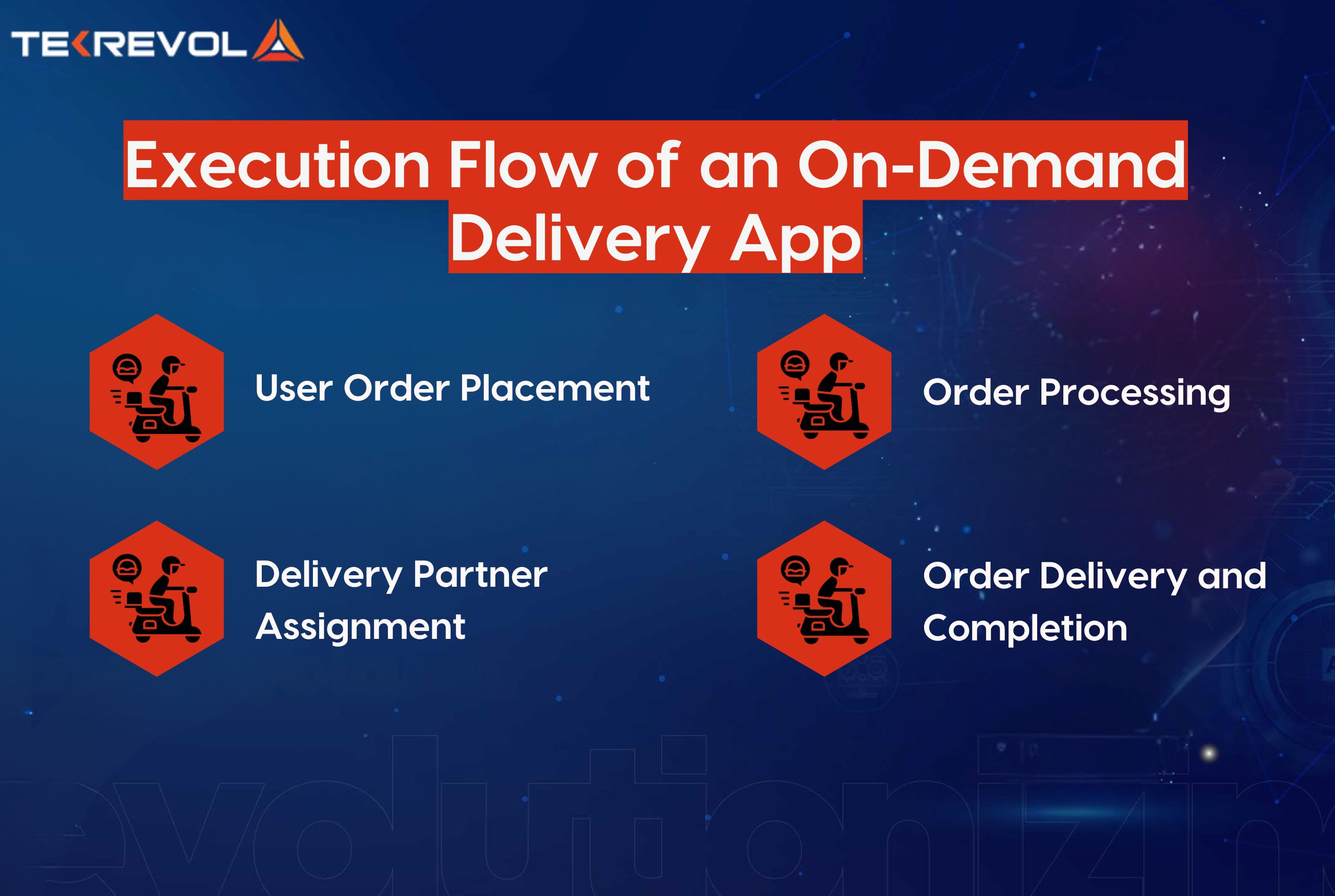
1. User Order Placement
It begins when the user places an order using the app. This action lays the foundation for the experience as a whole.
- Browsing & Selection: Users browse existing products or services through search, filter, or categories. After which, they place items in their cart.
- Checkout: Users check their choices, select a delivery option, and enter or confirm the delivery address.
- Payment: Several safe payment methods are provided (credit/debit cards, mobile wallets, COD). Upon successful payment, the order is confirmed.
2. Order Processing
Once the order has been placed, it is taken to the processing stage, where the backend systems get everything ready for fulfillment.
- Order Confirmation: The app immediately confirms the order and conveys information to the user, like order ID, summary of items, and estimated delivery time.
- Preparation: The restaurant, store, or service provider is alerted to prepare the order. Live updates can be provided to the user in case they want to be informed.
3. Delivery Partner Assignment
Logistics operations are running efficiently at this stage. The app knows and assigns the most appropriate delivery partner.
- Smart Assignment: The closest available delivery agent is assigned based on GPS and availability status. The agent is provided with all order and pickup information.
- Order Pickup: The delivery partner picks up the order and sets the app status to “Out for Delivery,” sending a notification to the user.
4. Order Delivery and Completion
This final phase brings the product or service to the doorstep of the user.
Real-Time Tracking: The application has real-time tracking so customers can track the delivery in real-time, gaining confidence and reducing worry.
Successful Delivery: Upon successful delivery, the status becomes “Delivered.” The application can prompt the user to rate their experience and provide feedback.
Proven Ways to Make Money from Your On-Demand Delivery App
Here are three tested ways to earn sustainable revenue from your app:
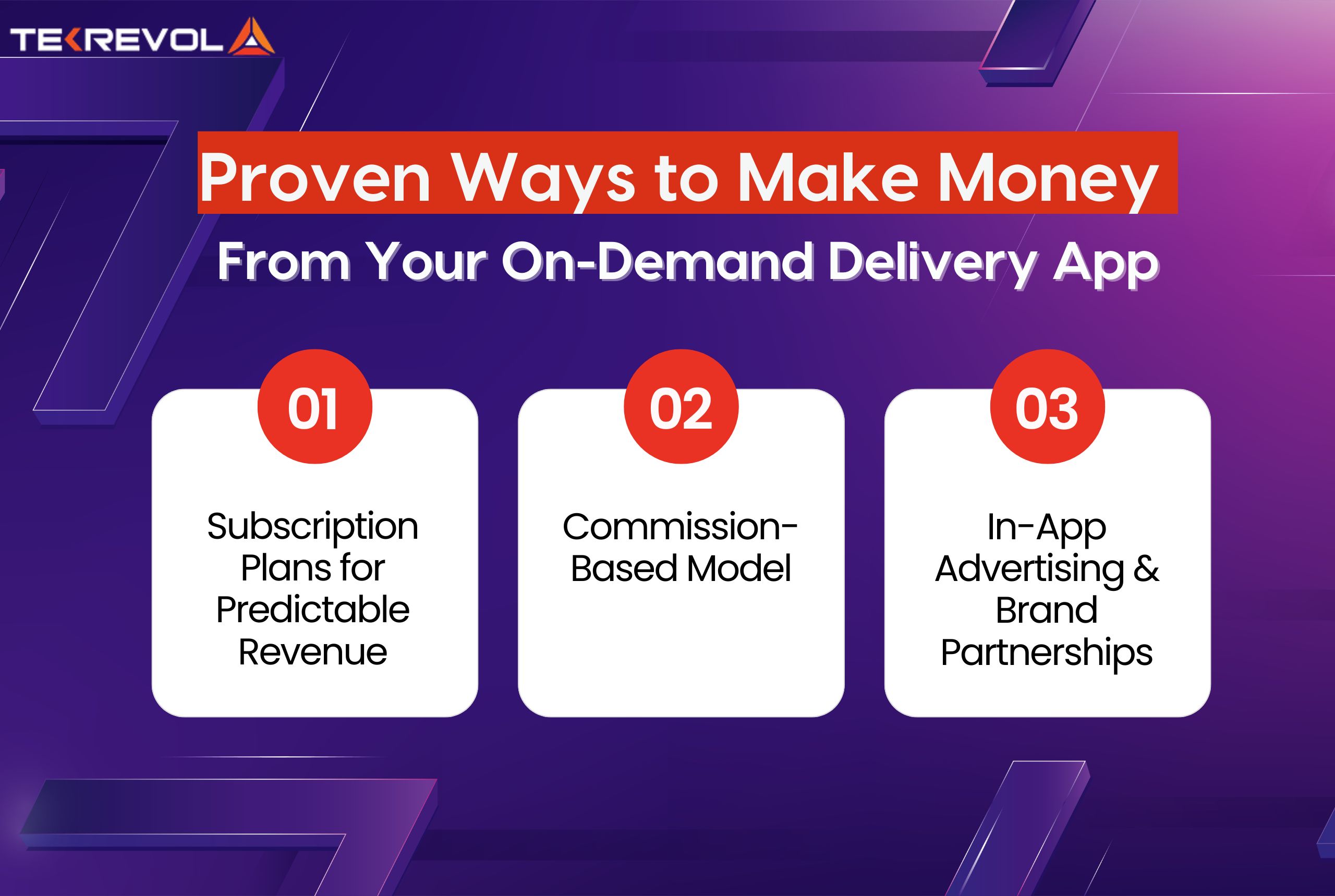
1. Subscription Plans for Predictable Revenue
Providing subscription-based services is an excellent approach to earning predictable revenue.
- How it works: Customers pay a regular fee (monthly or annually) for premium perks like free shipping, exclusive offers, or priority service.
- Best suited for: Food delivery and grocery platforms wishing to boost customer loyalty and provide guaranteed income.
2. Commission-Based Model
This is among the most used monetization strategies for delivery apps.
- How it works: The app charges a percentage commission to businesses (restaurants, stores, service providers) for each successful order.
- Balance is paramount: Although this model achieves stable revenue, a high commission rate may be difficult for small businesses to handle. Ensuring fees are reasonable ensures that partners stick around and the ecosystem remains healthy.
Example: Applications such as Uber Eats use this model, profiting from each completed order through their platform.
3. In-App Advertising & Brand Partnerships
Collaborating with brands and providing sponsored positions has the potential to be a win-win situation.
- How it works: Companies pay to be listed more noticeably in search results, homepages, or banner positions within the app
- Non-intrusive alternatives: Instead of pop-up ads, highlight local businesses through carefully curated listings or featured sections.
- Who wins: Both the app and business partners get seen and sold.
Understanding the Different Types of On-Demand Delivery Apps
These are the four primary types of on-demand delivery apps making daily life quicker and more convenient:
1. Food Delivery Apps
Bring Restaurants to Your Doorstep. These apps help consumers order from their favorite restaurants with a few taps. Lunch, dinner, or midnight munchies, food delivery apps have it all.
If interested in entering this domain, spending on on-demand food delivery app development can help you reach a fascinating and convenience-oriented market.
Key Features: Browse menu, track order, real-time ETA, scheduled delivery.
Popular Apps: Uber Eats, DoorDash
Why Users Love Them: Convenience, variety, and the comfort of having restaurant-quality food at home.
2. Grocery Delivery Apps
Grocery delivery applications allow users to order necessities without entering a store. Ideal for hectic lifestyles or for those who wish
Key Features: Product search, category browsing, real-time inventory updates, scheduling for delivery.
Popular Apps: Instacart
Why Users Love Them: Time-saving, provides flexibility, and decreases store stress.
3. Parcel Delivery Apps
These apps simplify shipping and receiving packages than ever. Personal packages, business deliveries, everything is done through an app.
Key Features: Scheduling pickup, real-time monitoring, and delivery reminders.
Popular Apps: FedEx, UPS Mobile
Why Users Love Them: Trackable, secure, and more convenient than going to courier offices.
4. Service Delivery Apps
Looking for a handyman, cleaner, or beauty professional? Service delivery apps match users with professionals for home-based work and services
Key Features: Listings of service providers, booking within the app, pricing upfront, and rating systems.
Popular Apps: TaskRabbit
Why Users Love Them: Saves time, guarantees quality service, and provides a lot of assistance from vetted experts.
Real-World Applications of On-Demand Delivery Apps
On-demand delivery apps are no longer only for food or grocery deliveries. Their convenience, flexibility, and scalability have caused their influence to reach several sectors. Have a look at how different industries are utilizing these platforms.
1. Healthcare Delivery Services
Doctor-on-demand apps in the healthcare sector are revolutionizing the delivery of important medical resources to patients, making services quicker, more accessible, and effective.
Medicine Delivery: Such apps enable patients to upload a prescription and have medicine shipped directly to their home. It is particularly useful for older patients or those with mobility problems.
Medical Equipment & Supplies: Such sites even facilitate the delivery of critical healthcare equipment such as blood pressure meters, wheelchairs, and diagnostic equipment, increasing access to medical supplies at home.
2. E-commerce & Logistics
Delivery apps have transformed the way online shopping operates by reducing delivery time and logistics inefficiencies.
Smooth Order Completion: Retailers such as Amazon utilize delivery apps to interact between warehouses, riders, and consumers, guaranteeing prompt deliveries and real-time tracking of orders.
Same-Day and One-Hour Delivery: Apps now facilitate super-fast delivery options for high-priority products, elevating customer satisfaction and convenience to new heights.
3. Laundry and Dry-Cleaning Services
Hectic city lives have fuelled the rise of full-service convenience offered by laundry-based delivery apps.
On-Demand Laundry: Applications such as Rinse enable users to book pickups for dirty clothes. They are washed, folded, and returned, all without leaving the house.
Alterations and Repairs: A few laundry delivery applications also provide additional services such as tailoring, hemming, and minor mending, making them a convenient one-stop shop for clothing care.
On-Demand App Costs: What Influences Pricing the Most?
Building an on-demand delivery app isn’t a fixed-cost process, it depends on what your app needs. Things like advanced features, cross-platform support, and third-party integrations all add up, along with the region where your development team operates.
Here’s a general breakdown to give you an idea:
| App Type | Estimated Cost | Features |
| Basic Delivery App | $30,000 – $50,000 | User registration, order placement, basic tracking, and payment integration. |
| Moderately Complex Apps | $60,000 – $80,000 | Custom UI/UX, advanced tracking, admin panel, and support for multiple user roles. |
| Highly Complex Apps | $100,000+ | Real-time analytics, AI recommendations, custom APIs, and scalable cloud backend. |
Note: The prices mentioned above are estimates. To get an accurate cost tailored to your project, please contact a trusted on-demand app development company.
- Need an accurate cost for your on-demand delivery app?
- Share your project requirements and receive a personalized quote instantly or use our cost calculator!
Choose Tekrevol for Expert On-Demand Delivery App Development
Tekrevol is a top mobile app development firm, excels in developing scalable and innovative on-demand delivery app solutions that are developed to specifically meet the requirements of our unique clients.
We focus on a customer-centric process to make sure your app not only works flawlessly but also offers a seamless and engaging experience to users.
With a proven track record of completed projects and happy customers, Tekrevol strives to translate your ideas into reality in the form of powerful, state-of-the-art on-demand delivery platforms that drive business growth and customer loyalty.
- Want to build an app that stands out in the delivery market?
- We help you with expert design, development, and support.

